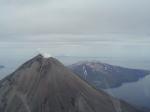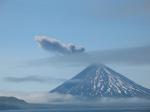Activity at Cleveland volcano
Steaming Cleveland volcano on July 27, 2007, its steep slopes mantled by grey debris ejected from the summit crater during recent explosions. Even the snow patches on Tana, an older volcano on the eastern portion of Chuginadak Island about 12 km (7 mi) east, are slightly grey with a dusting of what is probably Cleveland ash. The prominent peak on the horizon is 7051-ft-tall Vsevidof volcano on southwestern Umnak Island. Photography courtesy Andrew Rose and Maritime Helicopters.Closer view of the nearly 5700-ft-summit of Cleveland volcano on July 27, 2007. Water vapor and other gases billow from the steep-walled crater, approximately 150 m (490 ft) across. Prominent yellow-staining reflects precipitation of native sulfur from ongoing release of volcanic gas. Note the mantle of grey debris and blocks along the crater rim, probably produced during intermittent explosive activity at Cleveland over the past few weeks. Two days before this photo was taken, ASTER satellite data indicated temperatures as high as 359 C (678 F) in the summit region. Thermal anomalies have been seen intermittently by satellite since early June when this recent period of elevated activity apparently began. Photography courtesy Andrew Rose and Maritime Helicopters.
Small explosion at Cleveland volcano on July 20, 2007. This photo, taken from the USFWS research vessel Tiglax, shows a small ash cloud rising a few thousand feet above the summit and drifting downwind. This type of intermittent explosive activity is likely characteristic of the current level of unrest at Cleveland. Such small ash clouds can easily go undetected on satellite imagery. Photo courtesy of Doug Dasher, ADEC and Max Hoberg, School of Fisheries, UAF


